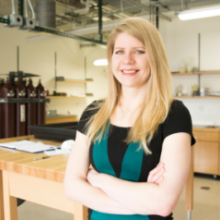-
Title
Staff Scientist -
Email
bertsch5@llnl.gov -
Phone
(925) 423-7995 -
Organization
PLS-MSD-MATERIALS SCIENCE DIVISION
Research interests
Additive Manufacturing of Metals
- Functionally graded materials- alloying and performance
- Alloy design
- Directional solidification microstructure formation and evolution
- Influence of AM microstructures on performance
- Phase transformations
- Optimization and control of AM microstructures utilizing advanced laser systems
- Post-processing for optimization of microstructure
- Steels, Ti-based alloys (β/metastable β alloys e.g. Ti-5553 as well as multiphase alloys e.g. Ti64), FCC materials, refractory alloys
Mechanical response, plastic deformation mechanisms, and failure mechanisms
- Dislocation structures and evolution
- Influence of grain boundaries and interfaces on deformation and failure
- Strengthening mechanisms
- Failure initiation
- Fractography and fracture modes
- Mesoscale interactions from deformation through failure
- Mechanics
- High-temperature deformation (Gleeble system)
Hydrogen embrittlement of structural metals
- Hydrogen effects on deformation/plasticity mechanisms and failure mechanisms
- Mesoscale influence of hydrogen on material response
- Hydrogen diffusion and uptake
- Gaseous hydrogen environment effects and electrochemical corrosion
- In situ corrosion/embrittlement testing
- Hydriding materials (Ti-based alloys)
Microstructural characterization
- Electron microscopy techniques: TEM, STEM, EELS, SEM, EBSD, EDS
- Mesoscale/multi-length scale characterization through linking of nano- through bulk-scale analysis techniques
- Optical microscopy
- XRD
- Combining electron microscopy techniques with spectroscopy e.g. SIMS/NanoSIMS
Current Projects
Currently PI of multiple projects including:
LDRD focused on optimization of additively manufactured functionally graded metals integrating experiment and computation
Internal project focused on developing new methods of optimizing metal AM microstructures as well as understanding links between AM structures and mechanical properties, particularly focused on performance of complex geometries and Ti or refractory alloys.
Contributor to multiple projects focused on mechanical testing, high-temperature mechanical testing, and microstructural characterization of alloys before and after deformation and failure.
Career path
Kaila joined LLNL in 2019 in the Metallurgy and Advanced Microscopy group. She led a Lab-Wide LDRD from 2020-2022 focused on hydrogen embrittlement of metals and AM metals, an external project from 2021-2022 focused on combining electron microscopy techniques with SIMS/NanoSIMS spectroscopy techniques, and began leading her current projects in 2021-2022. The projects she leads currently fund approximately 15 staff scientists and postdocs, and she acts as mentor to approximately 5 postdocs.
Prior to joining LLNL, Kaila worked as a postdoc at the University of Wisconsin-Madison, and obtained her graduate degree from the University of Illinois at Urbana-Champaign
Ph. D. Materials Science and Engineering, University of Illinois-Urbana-Champaign, 2017
B. S. Mechanical Engineering, Texas A&M University, 2012
Selected publications
- K.M. Bertsch, G. Meric de Bellefon, B. Kuehl, D.J. Thoma, Origin of dislocation structures in an additively manufactured austenitic stainless steel 316L, Acta Mater. 199 (2020) 19-33. https://doi.org/10.1016/j.actamat.2020.07.063
- K.M. Bertsch, K.E. Nygren, S. Wang, H. Bei, A. Nagao, Hydrogen-enhanced compatibility constraint for intergranular failure in FCC FeNiCoCrMn high-entropy alloy, Corros. Sci. 184 (2021) 109407. https://doi.org/10.1016/j.corsci.2021.109407.
- K.M. Bertsch, T. Voisin, J.B. Forien, E. Tiferet, Y.I. Ganor, M. Chonin, et al., Critical differences between electron beam melted and selective laser melted Ti-6Al-4 V, Mater. Des. 216 (2022) 110533. https://doi.org/10.1016/j.matdes.2022.110533.
- K.M. Bertsch, A. Nagao, B. Rankouhi, B. Kuehl, D.J. Thoma, Hydrogen embrittlement of additively manufactured austenitic stainless steel 316 L, Corros. Sci. 192 (2021) 109790. https://doi.org/10.1016/j.corsci.2021.109790.
- M. Moorehead, K. M. Bertsch, M. Niezgoda, C. Parkin, M. Elbakhshwan, K. Sridharan, et al., High-throughput synthesis of Mo-Nb-Ta-W high-entropy alloys via additive manufacturing, Mater. Des. 187 (2020) 108358. https://doi.org/10.1016/j.matdes.2019.108358.
- K.D. Koube, G. Kennedy, K. Bertsch, J. Kacher, D.J. Thoma, N.N. Thadhani, Spall damage mechanisms in laser powder bed fabricated stainless steel 316L, Materials Science and Engineering: A, Volume 851, 2022, 143622. https://doi.org/10.1016/j.msea.2022.143622.
- B. Rankouhi, K.M. Bertsch, G. Meric de Bellefon, M. Thevamaran, D.J. Thoma, K. Suresh, Experimental validation and microstructure characterization of topology optimized, additively manufactured SS316L components, Mater. Sci. Eng. A 776 (2020) 139050. https://doi.org/10.1016/j.msea.2020.139050.
- K.M. Bertsch, S. Wang, A. Nagao, I.M. Robertson, Hydrogen-induced compatibility constraints across grain boundaries drive intergranular failure of Ni, Mater. Sci. Eng. A 760 (2019) 58-67. https://doi.org/10.1016/j.msea.2019.05.036
- C.J. Rietema, J.D. Roehling, W.L. Smith, K.M. Bertsch, Microstructural control of additively manufactured Ti6Al4V via in-situ large-area laser annealing, Scr. Mater. (2023) 115823. https://doi.org/10.1016/j.scriptamat.2023.115823
Professional services
Vice chair, The Minerals, Metals, & Materials Society Corrosion and Environmental Effects Committee


